Top performers in the collision industry are always on the lookout for more profitable ways to produce quality jobs. But assuming your shop exists in a “collision repair” vacuum can sometimes lead to trouble if you lose customers because a competitor offers more.
The fact is, there’s more to maintaining and fixing a vehicle than just collision repair. By including such options as sunroof installation/service, A/C system service and power accessory service at your shop, you can attract new customers. And wouldn’t it be great if hordes of new customers – who have no need for collision repair work – looked to your shop as a service provider?
Let the Sunshine In
Motorists are always looking for ways to differentiate their cars from other vehicles that are shaped the same and painted the same color. Adding an aftermarket (A/M) sunroof can be one option for such a customer.
In the past, concerns about the structural integrity of a vehicle with an A/M sunroof were a hot issue. Today, they’re not altogether resolved, according to those I spoke with. Sunroof manufacturers have addressed the problem by using high-grade materials and by making available reinforcement track rails that add to the structural integrity of the cut-out roof panel. Still, many shops shy away from installing sunroofs.
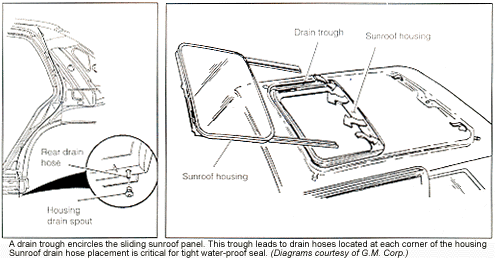
Quite a few, however, work on them as part of a collision job or as a service option. Many shop owners I spoke with said the real profits come from keeping already-installed OE and A/M sunroofs operational and leak free.
Denny Hines, service specialist from Caribbean Autobody in Chula Vista, Calif., repairs sunroofs for area Volvo owners and for a few local dealers. This in-house accessory service has become a “specialty of the house,” but Hines says a few basics must be considered when servicing most sunroof systems.
A typical complaint Hines hears is that the sunroof sticks when it’s closing. This problem is related to adjustment of the sunroof guides. Look for improper fitting of the roof to the enclosure when the roof is closed and latched. If such a problem is present, the sunroof probably has a wind-noise problem as well.
How do you service the problem? Hines ran through the procedure using a 1990 Volvo 740 GLE.
1. Check for broken guide rails.
2. Loosen the roof-rail screws from inside the car with the sunroof unit open, and move the sliding roof section into a more symmetrical position before re-tightening the screws.
Note: If the sunroof must be removed for a better look, use needle-nose pliers to release the spring clips that hold the sunroof liner to the roof. (This is done in the “vent” position.) Push the liner back into the area where the roof would normally retract so you’ll be able to get to the worm drive, cables or, in some cars, the motor and control module.
Another common sunroof problem Hines encounters involves being unable to put an automatic sunroof in the “vent” position. (Having had recent personal experience with the same problem on new Pontiacs, I was anxious to learn how Hines attacked the problem on the Volvo.)
If the sunroof won’t go to the vent position after it’s cycled completely closed and the power switch has been pushed again, look for signs that the sunroof isn’t aligned or has been manhandled. Customers will sometimes pry on the rear track area to force the sunroof upward. On the Volvo, the tracks are made of die-cast metal and will suffer permanent distortion requiring replacement of the affected parts. That means the sunroof probably won’t vent because of a binding condition in the roof panel. If the sunroof otherwise opens and closes, the worm drive and cables are normally OK.
According to Hines, sometimes a vehicle is sensitive to motor timing and an adjustment screw might need to be moved slightly to allow micro-switches to follow through with a power stroke to operate the roof in the vent position. (This is the problem I had personal experience with on the 1997-1999 Pontiac Grand Prix and Grand Am vehicles.)
Scoring Profits with A/C Service
A/C repair is a must during a job if the system was damaged in the accident. Today, however, more shops are purchasing new recovery and recycling equipment and bringing their facilities up to speed with EPA laws so they can provide A/C service not associated with a collision.
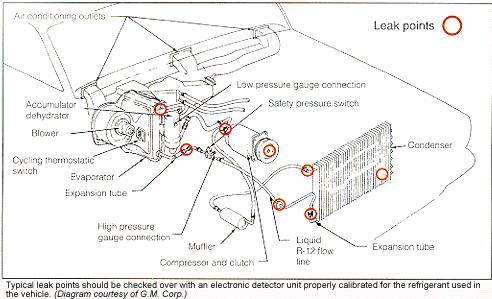
Bob Hamlin of Corradino Autobody in Trinidad, Co., has provided customers with routine A/C service for several years. How does he market the service? Occasionally, he runs a “nick and dent” special and advertises an A/C service special, which includes a leak check and re-charge at the same time.
Having a trained staff on hand, as well as UL- and EPA-certified equipment, is a critical first step in offering A/C service to non-collision customers. Once you’ve had a few customers in the shop for repairs, you’ll probably notice that correctly identifying leak areas is a trouble spot. Jay Reyes, A/C service specialist at Ozark Mobil A/C Service, offered some advice when dealing with this troublesome area:
1. Electronic leak detectors are very sensitive instruments, so the problems a tech faces when looking for a small leak are compounded by the background vapors found under the hood and in the VOC level in the shop. To combat that, select an area that’s not adjacent to solvent cleaning or drying areas. Keep the leak detector tip vents open and learn the sensitivity level adjustments for your particular unit.
2. Many leak detectors need to be re-calibrated to an entire new level of test sensitivity when switching from R-12 leak finding to HFC-134. Use the lowest level to keep the unit from emitting false alarms.
3. Whatever type of equipment you use to chase leaks, look for repeat alarms in several identical sweeps. False alarms won’t show up in this fashion.
If A/C service is a niche you’d like to get into, several training resources are available:
- Mobile Air Conditioning Society (MACS): (215) 679-2220.
- International Mobile Air Conditioning Society (IMAC): (817) 338-1100.
- Inter-Industry Conference on Collision Repair (I-CAR): (847) 590-1191 in the United States, (800) 296-1996 in Canada.
- The Stratospheric Ozone Information Hotline (an industry related information exchange): (800) 296-1996 or via the Internet at (www.epa.gov/ozone).
In addition to these resources, many parts manufacturers and specialty trainer and tool group companies provide individualized training on A/C systems. Check with your local vo-tech school for other certified programs.
We Need More Power
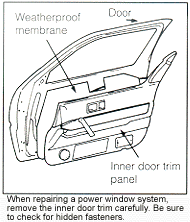
Jim’s Autobody in Forsyth, Mo., services power windows, power door locks and cruise-control systems on vehicles that may or may not have been involved in collisions.
Power windows that stick in the “down” position are a common problem, says owner Jim Burns. But when problems become more difficult to diagnose and repair, Burns stops the work and goes next door. Carl’s Automotive, a full-service mechanical repair shop, shares a building with Jim’s Autobody, and on occasion, the experts from Carl’s are called in to help.
Since power window operation is a common repair, I spoke with the techs from Carl’s about window motor service and replacement tips:
1. Be sure to park the vehicle so doors can be easily opened all the way.
2. If the vehicle has a motorized seatbelt system attached to the door, refer to a repair manual to be sure that you have the tools and equipment to correctly service the system before you start working.
3. Disconnect the vehicle’s power. To test the window’s operation, use a separate power unit with its own power and ground stations.
4. Search for inner trim panel screws that may be imbedded in carpeted areas on lower door panels or behind arm rests or may be otherwise concealed by plastic cover plugs or assist grips.
5. A modified gasket scraper is a favorite tool utilized at Carl’s when attempting to release pop-in fasteners used to hold trim panels to the door.
6. Never let the panel hang with switches and wires still connected. Look for the release mechanism, and disengage the connector to allow access to the window unit.
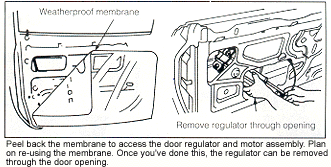
7. Tearing up and then failing to restore the door window plastic cellophane membrane is a good way to guarantee a quick customer comeback since water and moisture can damage the drive motor and linkage mechanism.
8. Cable or plastic tape drive units in window regulators need to be lubricated before you install new parts. Failure to lube in required areas will cause a repeat failure in as little as four or five weeks.
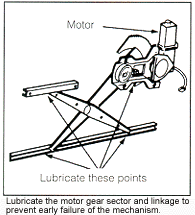
9. Never try to fight the regulator and motor components within the door structure. Always pull the window motor and regulator as a unit, and do the matching and assembly work on the bench.
10. Use alignment marks to set the new motor into position on the regulator housing and when mounting it in the door shell.
11. Check the window’s operation before putting the assembly back together. Adjust the glass and stop points as required.
Looking for Opportunities
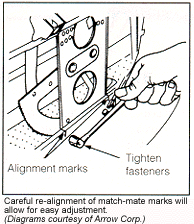
For many I spoke with, offering accessory and A/C service has been a profitable addition to their already-busy collision repair schedules. None of the shop owners I spoke with advertise that they’re a one-stop, “A to Z” service shop. Instead a single specialty, such as A/C service and repair, is what’s garnered a lot of new business.
“Taking advantage of special skills [of techs] in-house as well as equipment that’s already in place can be a solid investment in your shop’s future,” says Hamlin.
You already perform many of these mechanical operations daily in restoring collision-damaged vehicles, so why not offer them as additional services customers regularly need? Right now, customers are paying someone to provide these services. If you use your knowledge and experience to your full benefit, they could be paying you.
<hr?
Writer Bob Leone, a retired shop owner and contributing editor to BodyShop Business, is ASE Three-Way Master Certified and is completing qualifications as a post-secondary automotive instructor in the vocational-school system in Missouri.
|
Mechanical Money If you’re still contemplating adding a more traditional mechanical service to your shop’s offering but haven’t found the right one, consider the following options:
|













